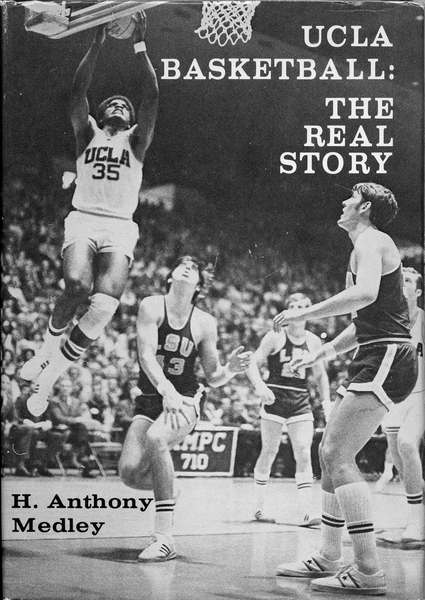|
Out of print for more than 30 years, now available for the first time as an eBook, this is the controversial story of John Wooden's first 25 years and first 8 NCAA Championships as UCLA Head Basketball Coach. Notre Dame Coach Digger Phelps said, "I used this book as an inspiration for the biggest win of my career when we ended UCLA's all-time 88-game winning streak in 1974." Compiled with more than 40 hours of interviews with Coach Wooden, learn about the man behind the coach. Click the Book to read the players telling their stories in their own words. This is the book that UCLA Athletic Director J.D. Morgan tried to ban. Click the book to read the first chapter and for ordering information. |
|
Julie & Julia (4/10) by Tony Medley Runtime 123 minutes. OK for children. I can’t say this is entirely worthless. There
is a scene at about the The producers clearly knew that there was no cinematic story to tell about Julia Child (Meryl Streep). She was a very tall television cook with a funny sounding voice. What’s to tell? So they combined her story (from her book)
with the story of Julie Powell ( I loved “Heartburn,” writer-director Nora
Ephron’s 1983 autobiographical novel about her marriage and breakup with
goofy, egotistical journalist Carl Bernstein. The big charm about
“Heartburn” is that you’re reading along and suddenly, boom! she inserts
a recipe out of the blue, then goes right along with her story. I still
make my cheesecake out of her recipe and people never fail to rave about
it. I liked “When Harry Met Sally” (1989), but was that due to her
script or Rob Reiner’s directing? This one she directs her own
screenplay and it is an ordeal to endure, despite pictures of
mouth-watering dishes, and some nice shots of As to Meryl Streep, she had a tough decision to make. I think actors make a big mistake when they try to precisely duplicate someone’s voice and mannerisms when portraying them in a movie. The performance of someone playing a real person in a biopic against which I weigh all others is that of Larry Parks in “The Jolson Story” (1946). Parks didn’t try to speak as Jolie spoke, and he lip synced to Jolie’s real voice for the songs. Otherwise, he played it straight up, interpreting Jolson as a man, not trying to mimic him. To me, that’s the most effective way to play someone in a biopic. When they give way to the urge to mimic the person, they risk appearing as a parody of that person. Jamie Foxx as Ray Charles was probably the only actor who did try to mimic and got away with it. Watching Foxx in that movie, I felt as if I were watching Charles. But in this film, Streep’s performance is little more than a caricature, and a bad one at that. I cringed every time she was on the screen. I was constantly aware that she was “acting,” which is a kiss of death. To say that Ephron’s script and direction are disappointing would be giving them too much praise. (Spoiler alert). During the course of the film, Julie’s wussy husband, Eric (Chris Messina), walks out on her. Ephron didn’t set this up right, because I thought he just went out to the store. Even though Julie recognizes that she’s being abandoned, she really doesn’t take it that hard. Oh, she’s upset, but not as devastated as the way I would imagine someone would be if the spouse they adored really did walk out. This unemotional response to a breakup has been a problem in other Ephron movies. Maybe Nora was so relieved to get away from Bernstein (which would certainly be understandable just from seeing him parade himself around on TV like a peacock) that she thinks everybody takes being dumped with such sanguinity. Not. In addition to innumerable scenes of cooking and food, there are lots of scenes that just don’t work. Maybe the worst is the one with Julie and Eric in bed watching Dan Akroyd play Julia on Saturday Night Live (Streep’s Julia reminded me more of Akroyd’s Julia than Julia’s Julia). Julie and Eric laugh uncontrollably but unconvincingly. They were about as convincing as the hired shills planted in the audience at my screening, a sure sign the studio is worried about a film. There is also a chronology problem here. Julie and Eric are watching this in the early 2000s. But Akroyd’s skit about Child appeared on SNL in December of 1978 when Julie and Eric were infants, at best. So maybe this is just a chick flick. It’s certainly catty enough to qualify. Ephron pictures Irma Rombauer (Frances Sternhagen), the author of the timeless “Joy of Cooking,” as confessing to Julia that she didn’t try out her recipes before publishing them. Maybe that’s true, but it’s hard to believe that she would admit it, especially to a competitor. At the end of the film Nora takes a shot at Julia herself. For Columbia Pictures’ sake, I hope that it will appeal to women because not too many guys are going to be able to sit through this too-long epic without being paid to laugh or to write a review. I was very disappointed because I was looking forward to it. |
|
|
